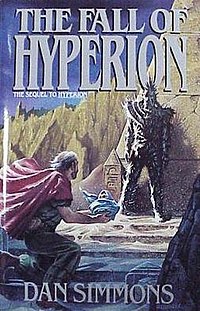The Fall of Hyperion (novel)

Cover of first edition (hardcover)
|
|
| Author | Dan Simmons |
|---|---|
| Cover artist | Gary Ruddell |
| Country | United States |
| Language | English |
| Series | Hyperion Cantos |
| Genre | Science fiction novel |
| Publisher | Doubleday |
|
Publication date
|
March 1990 |
| Media type | Print (Hardcover & Paperback) |
| Pages | 517 pp |
| Awards | Locus Award for Best Science Fiction Novel (1991) |
| ISBN | (First edition) |
| OCLC | 20093277 |
| 813/.54 20 | |
| LC Class | PS3569.I47292 F35 1990 |
| Preceded by | Hyperion |
| Followed by | Endymion |
The Fall of Hyperion is the second novel in the Hyperion Cantos, a science fiction series by American author Dan Simmons. The novel, written in 1990, won both the 1991 British Science Fiction and Locus Awards. It was also nominated for the Hugo Award that same year, and the Nebula Award in 1990.
Set in the 29th century, the novel documents a pilgrimage to the planet Hyperion, undertaken by eight people whose lives have been altered due to events regarding that world. The pilgrims intend to travel to the Valley of the Time Tombs, where the Shrike, a metallic creature alleged to grant one wish to the members of a pilgrimage, dwells. Each of the seven adult pilgrims has a wish that, if granted, could change the future drastically, and the events that the pilgrims experience on Hyperion could have major influences on their society, creating additional issues.
The Hyperion Cantos is influenced strongly by various works, including the poetry of John Keats and the teachings of the environmentalist John Muir, to the extent that a reincarnation of Keats narrates The Fall of Hyperion. The novel also contains explicit references to classical literature and modern writings, including the scientific works of the Jesuit and paleontologist Pierre Teilhard de Chardin, the physicist Stephen Hawking, and some of the fiction of author Jack Vance.
The universe in which the novel is set relies heavily on high technology. The planet Hyperion, one of the novel's major settings, is a protectorate of the Hegemony of Man, an interstellar governmental entity formed during a mass exodus from Earth, known in the novel as the Hegira. The Hegira was sparked by the apparent destruction of Earth in an accident caused by sentient artificial intelligences. These artificial intelligences were members of the TechnoCore, an immense assemblage of these personae that has "seceded" from its creator, humanity, to which it serves as a type of advisory body. The artificial intelligences can appear in a series of computerized realities, based on cislunar spheres, that are also accessed by humans, but as a type of internet; however, the true residence of the TechnoCore is unknown to the Hegemony. Despite this fact, relations between the two entities are strong, and the TechnoCore has granted a complex form of technology, the farcaster, to the Hegemony, allowing for humans to step through a portal from one location to another, even if the two are separated by great distances. Numerous planets have established large amounts of farcaster connections with one another, forming the "WorldWeb", which is the core of the Hegemony. As the level of technology progresses, so do the religious views of the WorldWeb populace, which is mentioned to adhere largely to a hybrid religion of Zen Buddhism and gnosticism, although a significant minority belong to cults such as the Church of the Final Atonement, which worships the Shrike and the retribution it believes the creature will bring upon society for humanity's past errors. The almost-forgotten Catholic Church nevertheless plays a major role throughout the novel, as one of its priests is among the pilgrims to Hyperion.
...
Wikipedia
